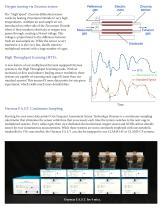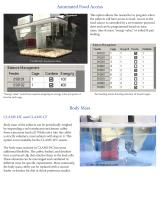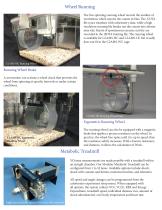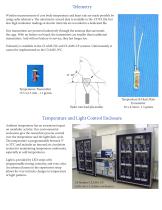 Website:
Columbus Instruments
Website:
Columbus Instruments
Catalog excerpts

Columbus Instruments Comprehensive Lab Animal Monitoring System CLAMS has been the industry leading metabolic monitor since 1999, and our vast and distinguished customer base helps drive improvements and innovations which places the system at the forefront of metabolic and behavioral research. Each system is built on a semi-custom basis to include as many, or as few options that are needed to meet the experiment needs or budget. Customers not only choose the parameters to be measured, but also a variety of cage environments to cover all potential applications. No matter the challenge, we have something that will work. CLAMS-HC for home cages: CLAMS Center-feeder CLAMS-WC for waste cages Our most popular offering, the cage most closely resembles the normal IVC cage, which lowers stress and facilitates acclimation. The cage and cage parts are cage-washer safe, making for a real “work horse” that is robust, reliable, and easy to use on a daily basis. An ideal cage design for obese models or for experiments that require the highest possible certainty for food intake measurements. Powdered food is presented from the floor, a large spill cup catches spillage, and the feeder is designed to eliminate food caching and foraging. Urine and feces collection require a novel and uniquely shaped cage, with a funnel beneath a wire floor that allows waste material to fall through for collection. We have mechanically adapted many of our CLAMS sensors to fit on these “metabolic” cages. Columbus Instruments 950 N. Hague Ave Columbus, OH 43204 U.S.A. Phone: [614] 276.0861 Toll Free: [800] 669.5011 Fax: [614] 276.0529 Email: sales@colinst.com
Open the catalog to page 1
Calorimetry (Oxymax) In general terms, measuring the exchange of carbon dioxide for oxygen is known as indirect calorimetry. The ratio of the exchange varies depending on if the animal is metabolizing fat, carbohydrate, protein, or a mixture of the three. This exchange can be monitored by placing the subject inside a sealed cage and precisely throttling the air-flow to create small differentials of oxygen and carbon dioxide between fresh air in vs. sample-out of the cage. A variety of gas sensing technologies exist for measuring these differentials. As our systems are highly customizable...
Open the catalog to page 2
Oxygen sensing via Zirconia sensor: The “High Speed” Zirconia differential sensor works by heating Zirconium Dioxide to very high temperatures. Ambient air and sample air are introduced on either side of the Zirconium Dioxide where it then conducts electricity as oxygen ions passes through, creating a Nernst voltage. This voltage is proportional to the difference between fresh air and sample air. While the sensor is very expensive, it is also very fast, ideally suited to multiplexed systems with a large number of cages. High Throughput Scanning (HTS): A new feature of our multiplexed...
Open the catalog to page 3
Animal activity is recorded with an array of infrared photo beams that surround the cage. As the animal moves, the beams are interrupted. Rapid breaks of the same beam over and over indicate fine repetitive movements like grooming. And since the beams are arranged in a grid pattern, the XY position of the animal can be continuously recorded. When equipped with the Z axis sensor, rearing events can be detected. Photo beam activity monitoring has been a staple of behavioral monitoring for decades, and we provide a few different activity data files to help digest the rich data. More commonly...
Open the catalog to page 4
One of the largest differences between cage types is the presentation of food. This can have a large impact on the feeding behavior and the amount of food eaten during the experiment. Each has it’s pros and cons, but some exist for very specific experiment conditions. Data is recorded in both a high resolution file and the event driven .BDTA bout file. CLAMS-HC The overhead feeder is designed to place the food in a familiar location and in pellet form, just like the IVC cage. A spillage catch beneath the pellets catches crumbs so the weight is accounted for. The animal has access to eat the...
Open the catalog to page 5
Balance Management “Energy value” restriction requires assigning an energy value per gram of food in each cage. This option allows the researcher to program when the subjects will have access to food. Access to the food source is controlled by a servomotor-powered door and can be programmed based on time, mass, time & mass, “energy value,” or yoked & pair feeding. CLAMS-HC and CLAMS-CF Body mass of the subjects can be periodically weighed by suspending a red translucent enrichment cubby from a precision load cell. While entry into the cubby is strictly voluntary, most subjects will sleep in...
Open the catalog to page 6
Drinking Drinking can be monitored either by mass or with our patented Volumetric Drinking Monitor. Similar to the food intake data, drinking data is reported synchronously with the calorimetry data file. But also a high resolution drinking file and events recorded in the .BDTA bout file. CLAMS-CF and CLAMS-WC Our patented Volumetric Drinking Monitor (VDM) uses a small dosing pump to deliver water through, what look like, a standard sipper tube. Inside the sipper, however, is a water level detection circuit that signals the pump for more water when the animal drinks. CLAMS-HC drinking mass...
Open the catalog to page 7
Wheel Running The free spinning running wheel records the number of revolutions which reports the counts in bins. The .CDTA file syncs rotations with calorimetry data, while a high resolution running file breaks out the counts into shorter intervals. Bursts of spontaneous exercise activity are recorded in the .BDTA bouting file. The running wheel is available for CLAMS-HC and CLAMS-CF, but it sadly does not fit in the CLAMS-WC cage. CLAMS-HC Running Wheel Running Wheel Brake A servomotor can activate a wheel chock that prevents the wheel from spinning at specific intervals or under certain...
Open the catalog to page 8
Telemetry Wireless measurements of core body temperature and heart rate are made possible by using radio telemetry. The calorimetry synced data is available in the .CDTA file, but also high resolution readings at shorter intervals are recorded in a dedicated file. Our transmitters are powered inductively through the antenna that surrounds the cage. With no battery on board, the transmitters are smaller than traditional transmitters. And with no battery to service, they last longer too. Telemetry is available in the CLAMS-HC and CLAMS-CF systems. Unfortunately it cannot be implemented on the...
Open the catalog to page 9
